|
|

|
|
Author
|
Topic: Exploration Development Laboratory (Lockheed Martin, Houston)
|
Robert Pearlman
Editor Posts: 50516
From: Houston, TX
Registered: Nov 1999
|
 posted 09-14-2006 04:35 PM
posted 09-14-2006 04:35 PM
   
The Lockheed Martin Exploration Development Laboratory (EDL) was created by the company to support NASA's space exploration vision and goals, including Constellation and Project Orion. The EDL contains a full scale mockup of the Orion spacecraft, which is being used for volumetric, displays and controls studies. It also contains an Avionics Development Lab, which is a joint test bed developed by Lockheed Martin and Honeywell Defense and Space and is being used for the early integration and testing of the Orion avionics hardware. NASA and Lockheed Martin hosted reporters today at the EDL to view the mockup and avionics lab. Media were invited to 'board' the mockup and 'fly' Orion on an approach and docking to the International Space Station. Orion Project Manager Skip Hatfield and Astronaut Lee Morin, who is working on Orion's avionics design, were present during the tour. Full-Scale (5m) Orion Mockup 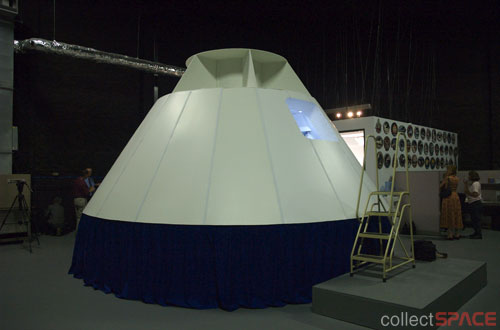  Astronaut Lee Morin explains Orion's avionics and window layout design. 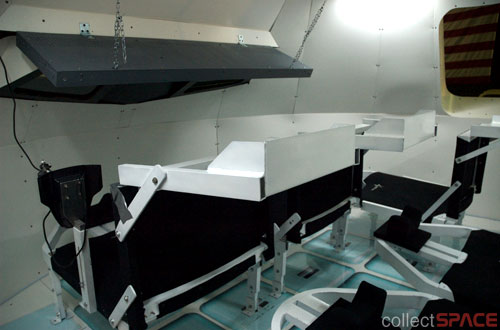 Command and pilot station.  Flat screen displays. (Orion will feature very few switch and gauge panels.) 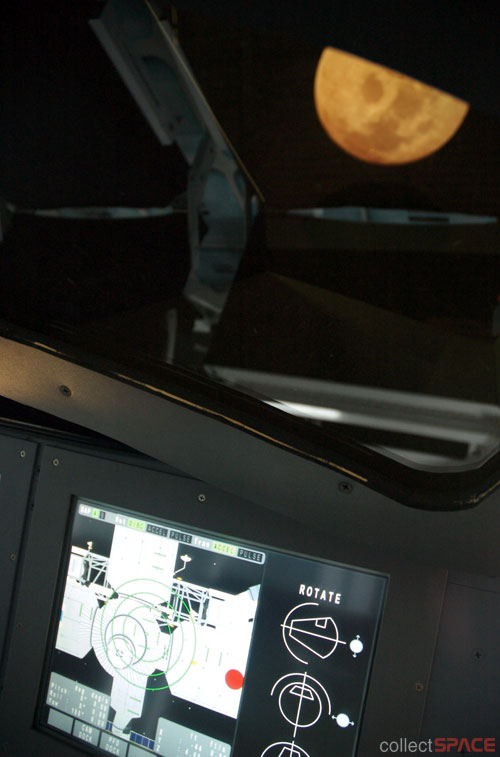 The view out the forward right window. |
Robert Pearlman
Editor Posts: 50516
From: Houston, TX
Registered: Nov 1999
|
 posted 09-14-2006 04:38 PM
posted 09-14-2006 04:38 PM
   
Full-Scale (5m) Orion Mockup (con't) 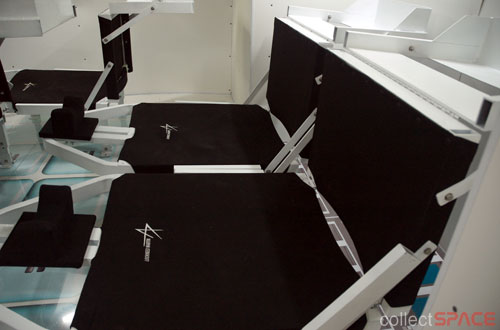 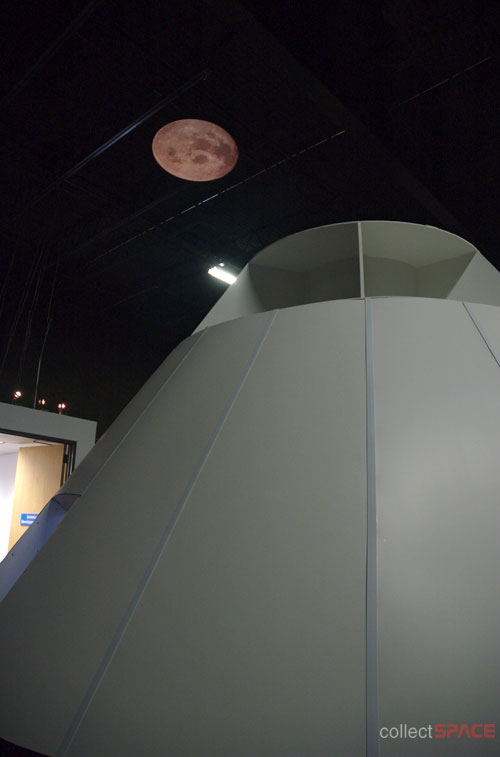 Avionics Development Lab  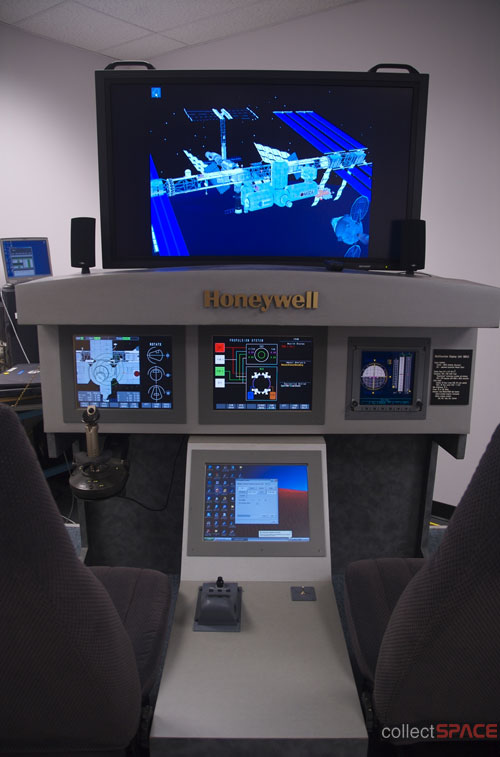  Steady, forward 0.10 ft/s, null your rates, docked! |
mensax
Member Posts: 861
From: Virginia
Registered: Apr 2002
|
 posted 09-15-2006 05:49 AM
posted 09-15-2006 05:49 AM
   
In the first photo... what are the items on the wall that the people in the background are looking at? What is the dimension on that window in the CM? It looks more the size of the Shuttle's than Apollo's. |
Scott
Member Posts: 3337
From: Houston, TX
Registered: May 2001
|
 posted 09-15-2006 08:13 AM
posted 09-15-2006 08:13 AM
   
Orion is a lot larger and more spacious inside than I had realized. Very impressive equipment and displays, too, as a result of today's technology. It is amazing we were able to go to the Moon, land on it and come back so many decades ago. |
mark plas
Member Posts: 385
From: the Netherlands
Registered: Aug 2000
|
 posted 09-15-2006 08:24 AM
posted 09-15-2006 08:24 AM
   
quote:
Originally posted by mensax:
In the first photo... what are the items on the wall that the people in the background are looking at?
I think they are looking at shuttle patches on the wall. |
Robert Pearlman
Editor Posts: 50516
From: Houston, TX
Registered: Nov 1999
|
 posted 09-15-2006 08:39 AM
posted 09-15-2006 08:39 AM
   
quote:
Originally posted by mensax:
In the first photo... what are the items on the wall that the people in the background are looking at?
Mark is correct; they are space shuttle mission insignia plaques, such as you see lining the wall of Mission Control. There was also a large Lockheed Martin CEV logo plaque on an adjacent wall. quote:
What is the dimension on that window in the CM? It looks more the size of the Shuttle's than Apollo's.
I can inquire about the dimensions but it appeared they are far smaller than the orbiter's forward panes but larger than the overhead or aft windows. The Orion mockup's windows were positioned such that during rendezvous and docking, undocking and reentry (among other flight phases), the commander and pilot can see forward in the direction they are traveling (so your view out in its current orientation is 'up' towards the ceiling). Other "side" windows are in the tradespace. (The 'window' through which you can see Lee Morin and myself is where the hatch would be installed.) |
mensax
Member Posts: 861
From: Virginia
Registered: Apr 2002
|
 posted 09-17-2006 09:20 AM
posted 09-17-2006 09:20 AM
   
I wonder if they will try to improve upon the hatch used in Apollo? I would think it would be hard to improve upon it's design as it was purely a mechanical piece, which millions of dollars were spent in designing. |
Robert Pearlman
Editor Posts: 50516
From: Houston, TX
Registered: Nov 1999
|
 posted 12-12-2007 11:57 PM
posted 12-12-2007 11:57 PM
   
On Wednesday, December 12, Lockheed Martin dedicated a new and expanded facility as their Exploration Development Laboratory, replacing the center documented earlier in this thread: Lockheed Martin Team Opens New Space Exploration Development Laboratory For Orion And ConstellationLockheed Martin announced today the opening of its new space Exploration Development Laboratory in a ceremony dedicating the facility to support the National Aeronautics and Space Administration's (NASA) Project Orion and Constellation Program. Orion isAmerica's next-generation human spaceflight vehicle that will transport up to six astronauts to and from the International Space Station and up to four to the moon and destinations beyond, beginning in 2015 after the space shuttle is retired. The new 10,000 sq. ft. Exploration Development Laboratory is a state-of-the-art test facility funded by Lockheed Martin and its teammates United Space Alliance and Honeywell as part of an integrated EDL network that includes facilities in Denver, CO, Glendale, AZ and Arlington, VA. The EDL network is designed to reduce cost and schedule risk by providing an early opportunity to perform systems level avionics and software testing for Orion in a realistic environment in the development phase of the program. "The Exploration Development Lab provides a tremendous benefit to NASA and the Lockheed Martin team as we begin a very robust test program for Orion," said Cleon Lacefield, vice president and program manager of Project Orion for Lockheed Martin Space Systems. "We are very excited to have the EDL ready and operational for Orion and Constellation so early in the development phase of the program. Testing in this new facility has already begun and we successfully completed the first Pad Abort 1 avionics systems test for Orion last week." The EDL in Houston is located adjacent to NASA Johnson Space Center, enabling the Lockheed Martin team to work closely with NASA's Project Orion and Constellation Program early in the development and testing phase to gain clarity on requirements. This location allows the team to take full advantage of the breadth of human space flight experience in Houston, including early involvement and collaboration with astronaut flight crew members and flight controllers. Initial testing of critical systems will be done in the EDL, including the Guidance, Navigation, and Control (GN&C), Automated Rendezvous and Docking (AR&D), crew interfaces, and software development processes. Avionics system testing will be performed to reduce risk prior to abort flight testing at White Sands Missile Range and NASA Kennedy Space Center. EDL testing also will include system integration tests and mission tests that employ the team's "test like you fly" philosophy. The Lockheed Martin team also is working closely with NASA on a Human Engineering mockup that will be used to perform fact finding activities, such as reach zone, panel displays, internal lighting assessment, seat mockup and development, docking hatch development, crew stowage, hand controller development, and other human interface devices. Following EDL testing, the next phase of tests will be done at NASA's CEV Avionics Integration Laboratory (CAIL). Verification of requirements in the EDL ensures that certification in the CAIL will be successful, greatly reducing software development risk. |
Robert Pearlman
Editor Posts: 50516
From: Houston, TX
Registered: Nov 1999
|
 posted 12-13-2007 12:18 AM
posted 12-13-2007 12:18 AM
   
A few photographs from inside Lockheed's Exploration Development Laboratory:  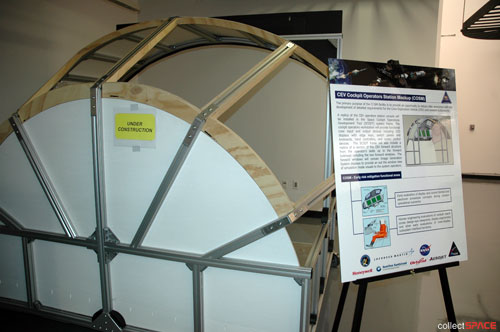 CEV Cockpit Operators Station Mockup (COSM) (under construction)The primary purpose of the COSM facility is to provide an opportunity to reduce risks associated with development of detailed requirements for the Crew Exploration Vehicle and avionics subsystems. A replica of the CEV operators station console will be installed in the Space Cockpit Operations Development Tool system frame. The cockpit operators workstation will provide functional crew input and output devices including LCD displays with edge keys, switch panels and keyboards, hand controllers, and cursor control devices. The SCODT frame will also include a replica of a section of the CEV forward structure from the operator's seats up to the forward bulkhead including the two forward windows. The forward windows will contain Image Generation System displays to provide an out the window view of simulation mode visuals to the system operators. 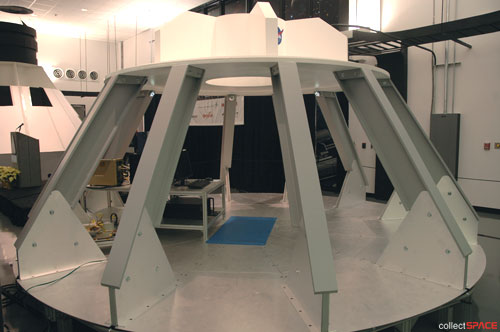 Pad Abort 1 - Crew Module MockupThe Pad Abort 1 (PA-1) Crew Module (CM) mockup will provide development and testing capabilities for the integration and evaluation of the PA-1 crew module avionics system interfaced with external simulations and emulations of complete subsystems prior to installation in the PA-1 Flight Test Article crew module. Examples of avionics that will be tested using the crew module mockup include data acquisition units, remote interface units, power distribution units, vehicle management computers and other flight critical components. In the background of the above photo, you can see the same mockup that was previously located at the earlier EDL, now modified to include a docking tunnel mockup and with a redesigned interior, including changes to its avionics controls layout:  | |
Contact Us | The Source for Space History & Artifacts
Copyright 2023 collectSPACE.com All rights reserved.

Ultimate Bulletin Board 5.47a
|
|

|
 advertisement advertisement

|

























